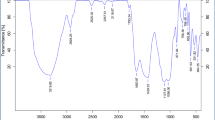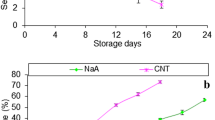Abstract
In the present work, the effect on biochemical indexes and microbial growth was studied in Norway lobster (Nephrops norwegicus), using a formulation containing 4-hexylresorcinol (0.1 and 0.05%) in combination with organic acids (citric, ascorbic and acetic) and chelating agents (ethylenediaminetetraacetic acid [EDTA] and di-sodium di-hydrogen pyrophosphate [PPi]). Lobsters treated with 4% of a commercial formula based on sulphites were used for control purposes. The treatment with 4-hexylresorcinol-based formulations delayed the increase in K-value and total volatile bases, while evolution of pH and trimethylamine was similar regardless of the treatment. No relation was found between biochemical and microbiological indexes. Regarding microflora, although commercial sulphites slightly slowed the growth of seafood spoiler organisms, as Shewanella putrefaciens and luminescent colonies, these organisms were not found in a very high number (∼6 log cfu/g) at the end of storage. Moreover, the formulation containing 4-hexylresorcinol 0.1% appeared to stimulate the growth of lactic acid bacteria. The sensory quality of lobster, in terms of melanosis, remained with a good appearance for 12 days. Formulations based on 4-hexylresorcinol preserved the quality and could therefore replace the traditional sulphites during storage of Norway lobster.










Similar content being viewed by others
References
Taylor SL, Bush RK (1986) Food Technol 40:47–52
McEvily AJ, Iyengar R, Otwell S (1991) Food Technol Sept.:80–86
Tanaka N, Luker C (1978) Abstract of the Annual Meeting of the American Society for Microbiology 78:188
Pyle ML, Koburger JA (1984) J Food Prot 47(5):375–377
Paleari MA, Beretta G, Cattaneo P, Balzaretti C (1985) Ind Aliment 24(226):371–375
Han JH (2000) Food Technol 54(3):56–65
Chang IS, Kim BH, Shin PK (1997) Appl Environ Microbiol 63(1):1–6
Doyle MP, Marth EH (1978) J Food Prot 41:891–896
López-Caballero ME, Pérez-Mateos M, Borderías JA, Montero P (2000) J Food Prot 63(10):1381–1388
Martínez-Alvarez O, Gómez-Guillén MC, Montero P (2005) J Food Prot 68(1):103–110
Montero P, Ávalos A, Pérez-Mateos M (2002) Food Chem 75:317–324
Montero P, Gómez-Guillén MC, Zamorano P, Martínez-Álvarez O (2003). In: Junta de Andalucia (ed) Estudios de los agentes conservantes e inhibidores de la melanosis en crustáceos. Consejería de Agricultura y Pesca, Spain
Montero P, López-Caballero ME, Pérez-Mateos M (2001) J Food Sci 66(8):1201–1206
Montero P, Martínez-Alvarez O, Gómez-Guillén MC (2004) J Food Sci 68(8):643–647
Saito T, Arai K, Matsuyoshi M (1959) Bull Jpn Soc Sci Fish 24:749–750
Antonacopoulos and Vyncke (1989) Zeit Lebens U Forsch 189:309–316
AOAC (1995) Trimethylamine nitrogen in seafood 971.14. Colorimetric methods (35.1.17). In: AOAC Official Method of Analyses, Chapter 35.7
Ritchie AH (1991) Techn Rep Torry Research Station. Aberdeen, Scotland
Ruíz-Capillas C, Morales J, Moral A (2003) Eur Food Res Technol 217:466–470
Layrisse ME, Matches JR (1984) J Food Prot 47:453–457
Ogawa M, Meneses ACB, Perdigao NB, Kozima TT (1983) Bull Suis Gakkai-Shi 49(6):975–982
Mendes R, Quinta R, Nunes ML (2001) Eur Food Res Technol 212:141–146
Yamanaka H, Shimada R (1996) Fish Sci 62:821–824
Shimada R, Ushio H, Yamanaka H (2000) Fish Sci 66:755–760
Fatima R, Qadri RB (1985) J Agric Food Chem 33:117–122
Ho M-L, Cheng H-H, Jiang S-T (1986) Bull Jpn Soc Sci Fish 52:479–488
Iyengar JR, Visweswariah K, Moorjani MN, Bhatia DS (1960) J Fish Res Bd Canada 17:475–485
Matches JR (1982) J Food Sci 47:1044–1047, 1069
Mendes R, Huidobro A, López-Caballero ME (2002) Eur Food Res Technol 214:125–130
Vanderzant C, Cobb BF, Thompson CA Jr, Parker JC (1973) J Milk Food Technol 36:443–446
Mietz JL, Karmas E (1977) J Food Sci 42:155–158
Huidobro A, López-Caballero ME, Mendes R (2002) Eur Food Res Technol 214:469–475
López-Caballero ME, Gonçalves A, Nunes L (2002) Eur Food Res Technol 214:192–197
Chinivasagam HN, Bremner HA, Reeves R (1998) L Appl Microbiol 27:5–8
Karmas E (1981) Lebesn Wiss U Technol 14(5):273–275
Zuberi R, Fatima R, Qadri RB (1988) Pak J Sci Ind Res 31(11):768–773
Gram L, Huss HH (1996) Int J Food Microbiol 33:121–137
Chinivasagam HN, Bremner HA, Thrower SJ, Nottingham SM (1996) J Aquat Food Prod Technol 5:25–50
López-Caballero ME, Álvarez MD, Sánchez-Fernández JA, Moral A (2002) Eur Food Res Technol 215:390–395
Pascual MR (1992) Mariscos (Crustáceos y Moluscos). In: Pascual MR (eds) Microbiología alimentaria. Diaz de Santos, Madrid, Spain, pp 183–195
Finne G (1982) Enzymatic ammonia production in penaeid shrimp help on ice. In: Martin RE, Flick GJ, Hebard CE, Ward DR (eds) Chemistry and biochemistry of marine food products. Wesport, USA, pp 323–331
Sidhu GS, Montgomery WA, Brown MA (1974) J Food Technol 9(3):357–370
Applewhite LD, Otwell WS, Rashan JM (1996) Inhibition of enzymatic browning in spiny lobsters by 4-hexylresorcinol. IFT Annual Meeting. Book of abstracts, p 79, ISSN 1082–1236
Yamagata M, Low LK (1995) J Food Sci 60(4):721–726
Nokodemusz I, Rodriguez EO, Almaguer MCBA, Ibarguren MF (1973) Elelmiszervizsgalati Koezlemenyek 19(5):257–260
Acknowledgements
The authors wish to thank the Consejería de Agricultura y Pesca de la Junta de Andalucía (Project CSIC-2000-664) and the European Union (Project CRUSTAMEL, FAIR-Life-CRAFT/001/1312) for co-financing the research. Author López-Caballero is under contract Ramón y Cajal, MEC-CSIC.
Author information
Authors and Affiliations
Corresponding author
Rights and permissions
About this article
Cite this article
López-Caballero, M.E., Martínez-Álvarez, Ó., Gómez-Guillén, M.C. et al. Quality of Norway lobster (Nephrops norwegicus) treated with a 4-hexylresorcinol-based formulation. Eur Food Res Technol 222, 425–431 (2006). https://doi.org/10.1007/s00217-005-0125-8
Received:
Revised:
Accepted:
Published:
Issue Date:
DOI: https://doi.org/10.1007/s00217-005-0125-8




